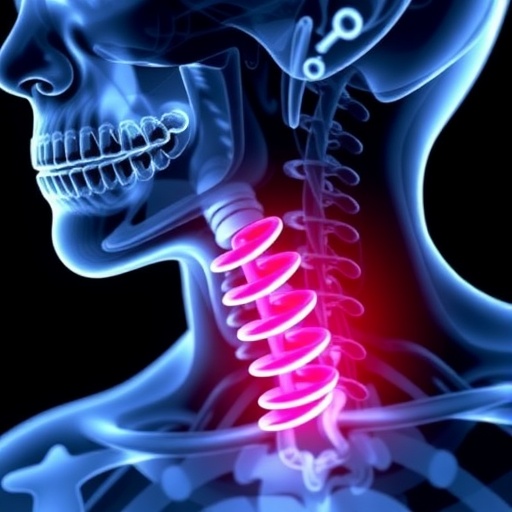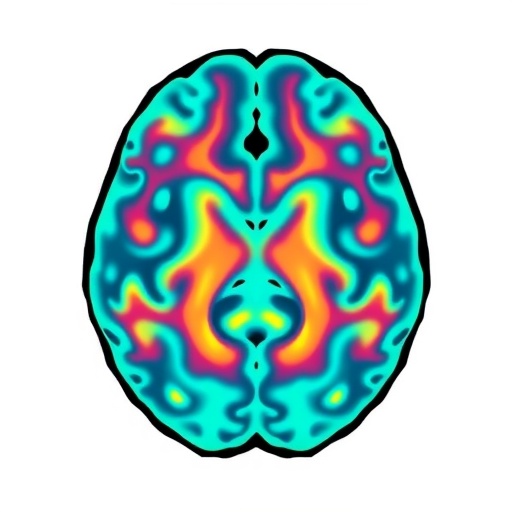
A groundbreaking study published in BMC Cancer has unveiled a pivotal biomarker for predicting recurrence in patients with papillary thyroid carcinoma (PTC) following total thyroidectomy. This discovery centers on postoperative anti-thyroglobulin antibody (TgAb) levels, which have been identified as a robust prognostic indicator for disease relapse. The research, encompassing a vast cohort of over 4,400 PTC patients, signifies a leap forward in personalized medicine and postoperative monitoring in thyroid cancer management.
Papillary thyroid carcinoma stands as the most common form of thyroid cancer, with its incidence rising globally, largely attributed to enhanced detection methods and incidental findings during unrelated medical evaluations. While the overall prognosis for PTC is favorable, boasting a 10-year survival rate exceeding 90%, the challenge remains in effectively identifying patients at heightened risk for locoregional recurrence. Traditional monitoring relies heavily on serum thyroglobulin (Tg) as a biomarker; however, the presence of circulating TgAb complicates interpretation by interfering with Tg assays, diminishing their reliability.
In a meticulously designed retrospective analysis, researchers from Gangnam Severance Hospital examined medical records spanning nearly two decades, from 2004 to 2022. Initially sifting through data from more than 15,000 patients who underwent bilateral total thyroidectomies, the team refined their focus to a cohort of 4,434 individuals diagnosed explicitly with PTC and possessing measurable postoperative TgAb levels. This substantial dataset provided unprecedented statistical power to elucidate the clinical significance of TgAb after thyroidectomy.
.adsslot_FX9rPgGqi8{width:728px !important;height:90px !important;}
@media(max-width:1199px){ .adsslot_FX9rPgGqi8{width:468px !important;height:60px !important;}
}
@media(max-width:767px){ .adsslot_FX9rPgGqi8{width:320px !important;height:50px !important;}
}
ADVERTISEMENT
The methodology incorporated rigorous TgAb measurements taken as early as two days post-surgery, followed by annual assessments to monitor dynamic changes over time. By correlating these antibody titers with clinical outcomes, the investigators sought to determine whether TgAb could transcend its previous role as merely an assay interference factor to emerge as a meaningful prognostic biomarker. Notably, the analysis did not confine itself to a single postoperative time point, enabling a more versatile application of TgAb testing in routine clinical follow-ups.
Findings from the study revealed a striking association between elevated TgAb levels and both increased tumor size and recurrence rates. Patients exhibiting TgAb concentrations exceeding 440 IU/mL demonstrated a recurrence rate of 13.3%, a significant jump compared to their counterparts with lower antibody titers. This threshold emerged not arbitrarily but through robust statistical modeling, positioning 440 IU/mL as a critical cutoff value that distinguishes high-risk individuals with an odds ratio of 6.0 for recurrence.
This newly identified TgAb threshold offers clinicians a potent tool to stratify patients based on their likelihood of relapse. The implications for disease-free survival (DFS) are profound, as patients exceeding the 440 IU/mL benchmark experienced markedly shorter DFS intervals. This contrasts with traditionally used markers and nurtures a nuanced understanding that antibody-mediated immune activity post-thyroidectomy is not merely a laboratory artifact but intimately entwined with tumor biology and patient outcomes.
The study challenges long-held diagnostic conventions by elevating TgAb from a confounding factor to a frontline prognostic value. This paradigm shift encourages the integration of TgAb quantification into postoperative surveillance protocols, potentially guiding therapeutic intensification or more vigilant imaging strategies for patients flagged at greater risk. In doing so, it aligns with the broader trend toward precision oncology, where individualized risk profiling tailors clinical interventions more effectively.
Moreover, the temporal flexibility of TgAb measurement recommended by the authors enhances its practicability. Unlike many biomarkers requiring strict timing or preparation, TgAb’s predictive validity persists regardless of measurement timing post-surgery, simplifying clinical workflows and patient compliance. This adaptability is particularly advantageous in diverse healthcare settings where regular, standardized post-thyroidectomy testing might be challenging.
The biological underpinnings of TgAb’s link to recurrence may reflect an intricate interplay between the immune system and residual tumor cells or microscopic disease foci. Elevated antibody levels might indicate ongoing antigenic stimulation from persistent cancerous tissue, heralding subclinical disease activity that precedes frank relapse. Future mechanistic studies are warranted to dissect these immunological dynamics, potentially opening avenues for immunomodulatory treatments targeting anti-thyroglobulin immune responses.
While the retrospective nature of the study imposes inherent limitations, including potential selection biases and unmeasured confounders, the sheer scale and consistency of associations bolster confidence in the findings. These results pave the way for prospective trials to validate the TgAb threshold in diverse populations and to explore its integration with other molecular and imaging biomarkers for comprehensive risk assessment.
In clinical practice, adopting this 440 IU/mL TgAb cutoff could revolutionize follow-up regimens for PTC patients worldwide. High-risk patients identified through this biomarker may benefit from intensified monitoring via ultrasound or cross-sectional imaging and may be candidates for adjuvant therapies aimed at minimizing recurrence risk. Conversely, patients with low TgAb titers might avoid unnecessary interventions, reducing healthcare costs and improving quality of life.
The integration of TgAb levels into existing guidelines for PTC management will require multidisciplinary collaboration among endocrinologists, surgeons, radiologists, and oncologists. Patient education about the significance of TgAb testing and its implications will be vital to ensure adherence and informed decision-making. Additionally, laboratory standardization of TgAb assays will be essential to maintain consistency and accuracy across institutions.
This research underscores the critical role of immune-related markers in oncology, expanding the lens beyond tumor-centric measures to include host-tumor interactions that influence disease trajectory. Anti-thyroglobulin antibodies, once sidelined as mere assay contaminants, now command attention as harbingers of recurrence, challenging clinicians to rethink surveillance paradigms and embrace biomarker-driven strategies.
As the global burden of thyroid cancer continues to rise, innovations in postoperative monitoring, such as those heralded by this study, are imperative to optimize outcomes and personalize care. By harnessing TgAb levels, healthcare providers may better anticipate and intercept PTC recurrence, ultimately enhancing survival and patient well-being.
In conclusion, the identification of a TgAb threshold of 440 IU/mL as a predictor of papillary thyroid carcinoma recurrence marks a significant advancement in thyroid oncology. This novel biomarker offers a practical, reliable, and clinically actionable measure to refine patient risk stratification post-thyroidectomy. As research progresses, it promises to reshape clinical practice and inform future therapeutic innovations aimed at curbing PTC relapse.
Subject of Research: Prognostic Value of Postoperative Anti-Thyroglobulin Antibody Levels in Papillary Thyroid Carcinoma Recurrence
Article Title: Anti-thyroglobulin antibody levels post-thyroidectomy and papillary thyroid carcinoma recurrence
Article References: Jeong, H.J., Lee, J.S., Lee, J.S. et al. Anti-thyroglobulin antibody levels post-thyroidectomy and papillary thyroid carcinoma recurrence. BMC Cancer 25, 1371 (2025). https://doi.org/10.1186/s12885-025-14709-5
Image Credits: Scienmag.com
DOI: https://doi.org/10.1186/s12885-025-14709-5
Tags: anti-thyroglobulin antibodiescancer prognostic indicatorslocoregional recurrence riskpapillary thyroid carcinoma recurrencepersonalized medicine in thyroid cancerpostoperative monitoring in thyroid cancerretrospective analysis of thyroid cancerserum thyroglobulin levelsthyroid cancer biomarkersthyroid cancer management strategiesthyroid cancer survival ratestotal thyroidectomy outcomes





